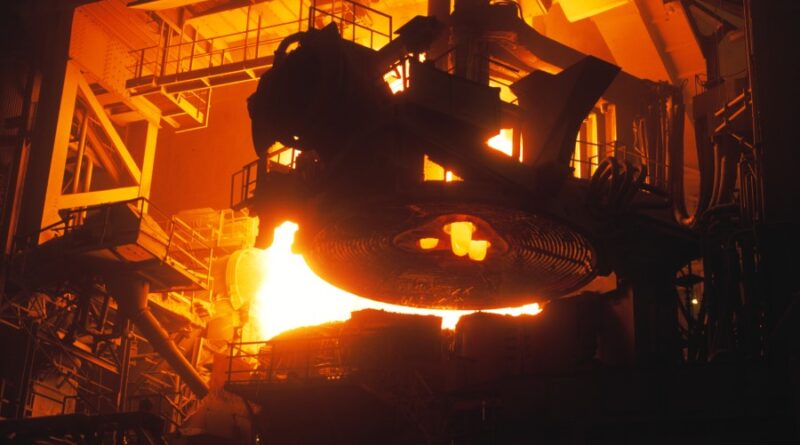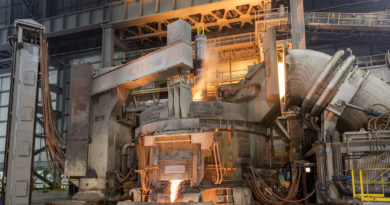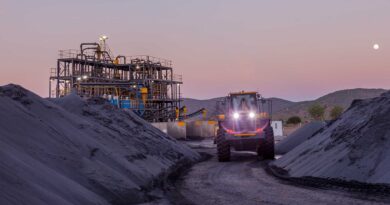FEATURED: Short range outlook for steel
The World Steel Association (worldsteel) has released its Short Range Outlook (SRO) for 2021 and 2022. worldsteel forecasts that steel demand will grow by 5.8% in 2021 to reach 1,874.0 million tonnes (Mt), after declining by 0.2% in 2020. In 2022 steel demand will see further growth of 2.7% to reach 1,924.6 Mt.
The current forecast assumes that the ongoing second or third waves of infections will stabilise in the second quarter and that steady progress on vaccinations will be made, allowing a gradual return to normality in major steel-using countries.
Commenting on the outlook, Mr Al Remeithi, Chairman of the worldsteel Economics Committee, said, “despite the disastrous impact of the pandemic on lives and livelihoods, the global steel industry was fortunate enough to end 2020 with only a minor contraction in steel demand. This was due to a surprisingly robust recovery in China, with growth of 9.1%. In the rest of the world steel demand contracted by 10.0%. In the coming years, steel demand will recover firmly, both in the developed and developing economies, supported by pent-up demand and governments’ recovery programmes. However, for most developed economies a return to the pre-pandemic levels of steel demand will take a few years.
While it is hoped that the worst of the pandemic is passing, there is still considerable uncertainty for the rest of 2021. The evolution of the virus and progress of vaccinations, withdrawal of supportive fiscal and monetary policies, geopolitics and trade tensions could all affect the recovery envisaged in this forecast.
For the future, structural changes in a post-pandemic world will bring about shifts in steel demand shape. The steel industry will see exciting opportunities from rapid developments through digitisation and automation, infrastructure initiatives, reorganisation of urban centres, and energy transformation. All at the same time as the industry is responding to the need to produce low-carbon steel.”
Background to the forecast
1) China
China’s economy quickly rebounded from the lockdown in late February, and almost all economic activity except retailing resumed full productivity by May. Since then, despite sporadic small localised waves of COVID-19, economic activity has not been affected by the pandemic, unlike the rest of the world.
The Chinese economy benefited from the government’s implementation of various measures to stimulate the economy. From several new infrastructure projects and accelerating existing projects, to relaxing control over the real estate sector and tax reduction to boost household consumption.
On top of this the economy benefitted from strong exports as the rest of the world was affected by the pandemic.
As a result, after contracting by 6.8% in the first quarter of 2020, China’s economy recorded annual growth of 2.3% in 2020. China’s GDP growth is expected to accelerate to 7.5% or higher in 2021, followed by moderate growth of 5.5% in 2022.
The construction sector had a fast recovery from April 2020, supported by infrastructure investment. For 2021 and onwards, real estate investment growth may decrease due to the government’s guidance to slow growth in the sector down.
Investment in infrastructure projects in 2020 reported a mild growth of 0.9%. However, as the Chinese government has kicked off a number of new projects to support the economy, the growth in infrastructure investment is expected to pick up in 2021 and continue to affect steel demand in 2022.
In the manufacturing sector, automotive production contracted the most by 45% during the lockdown, but has been recovering strongly since May. For the whole of 2020, auto production declined by only 1.4%. Other manufacturing sectors have shown positive growth due to strong export demand.
Due to the strong activity in the construction and machinery sectors, and with some inventory accumulations, apparent steel use rose by 9.1% in 2020. In 2021, it is expected that the stimulus measures introduced in 2020 will largely remain in place to ensure continued reasonable growth in the economy.
As a result, most steel-using sectors will show moderate growth and China’s steel demand is expected to grow by 3.0% in 2021. In 2022, steel demand growth will decelerate to 1.0% as the effect of the 2020 stimulus subsides, and the government focuses on more sustainable growth. The government’s reaction to the new US administration’s trade policy and the intensified environmental push add uncertainty.
2) Advanced economies
After the free-fall in economic activity in the second quarter of 2020, industry generally rebounded quickly in the third quarter, largely due to the substantial fiscal stimulus measures and unleashing of pent-up demand. However, activity levels still remained below the pre-pandemic level at the end of 2020. As a result, the developed world’s steel demand recorded a double-digit decline of 12.7% in 2020.
We will see substantial recovery in 2021 and 2022, with growth of 8.2% and 4.2% respectively. However, steel demand in 2022 will still fall short of 2019 levels.
Despite high infection levels, the US economy was able to rebound strongly from the first wave due to the substantial fiscal stimulus that supported consumption. This helped durable goods manufacturing, but overall US steel demand fell by 18% in 2020. The Biden administration recently announced a large fiscal proposal containing provisions for substantial infrastructure investment over a multi-year period.
The plan is expected to be considered by Congress in the second half of 2021 and, depending on its final form, may have upside potential for steel demand in the longer term. However, despite this and fast progress in vaccinations, steel demand recovery will be constrained in the short term by a weak rebound in the non-residential construction and energy sectors. The automotive sector is expected to recover strongly.
Similarly, the EU steel-using sectors suffered severely from the first lockdown measures in 2020, but experienced a stronger than expected post-lockdown rebound in manufacturing activities due to supportive government measures and pent-up demand. Accordingly, steel demand in 2020 in the EU27 and the UK ended with a better than expected 11.4% contraction. Italy and France recorded proportionately larger contractions due to the severest lockdown measures and collapsed tourism.
The recovery in 2021 and 2022 is expected to be healthy, driven by recovery in all steel-using sectors, especially the automotive sector, and public construction initiatives. So far, the EU’s recovery momentum has not been derailed by the ongoing third waves, but it remains fragile.
While there were fewer COVID-19 cases relative to the US or EU, the Japanese economy was also dealt a severe blow from the pandemic due to the interruption of broad economic activity and weak confidence that added to the effect of the October 2019 consumption tax hike. With a particularly pronounced fall in auto production, steel demand declined by 16.8% in 2020. The recovery in Japan’s steel demand will be moderate, driven by a rebound in the automotive sector with recovering exports and industrial machinery because of a worldwide recovery in capital spending.
South Korea’s economy escaped a large decline in GDP thanks to better management of the pandemic, and it saw positive momentum in facility investment and construction. Nevertheless, steel demand contracted by 8.0% in 2020 due to the contraction in the auto and shipbuilding sectors. In 2021-22, these two sectors will lead the recovery, which will be further supported by the continued strength in facility investment and government infrastructure programmes. Nevertheless, steel demand in 2022 is not expected to return to the pre-pandemic level.
3) Developing economics excluding China
Generally speaking, developing economies excluding China suffered more from the pandemic relative to the developed economies, with inadequate medical capacity, a collapse in tourism and commodity prices, and insufficient fiscal support. Steel demand in the developing economies excluding China declined by 7.8% in 2020. However, within the emerging economies, the picture was varied. India, MENA, and most Latin American countries suffered the most.
Benefitting from the global economic recovery and with renewed government infrastructure initiatives, steel demand in the developing economies is expected to show a relatively quick rebound in 2021 and 2022, with growth of 10.2% and 5.2% respectively. Accumulation of debts, no recovery in international tourism, and slow vaccination will prevent a faster recovery.
India suffered severely from an extended period of severe lockdown, which brought most industrial and construction activities to a standstill. However, the economy has been recovering strongly since August, much sharper than expected, with the resumption of government projects and pent-up consumption demand. India’s steel demand fell by 13.7% in 2020 but is expected to rebound by 19.8% to exceed the 2019 level in 2021. The growth-oriented government agenda will drive India’s steel demand up, while private investment will take longer to recover.
In ASEAN, disruptions to construction projects hit the fast-growing steel market, and steel demand contracted by 11.9% in 2020. Malaysia and the Philippines were the most severely hit, while Vietnam and Indonesia saw only a modest decline in steel demand. Recovery will be driven by a gradual resumption of construction activities and tourism, which will accelerate in 2022.
Latin American economies in general were severely hit by the pandemic and steel demand in 2020 recorded a double-digit contraction in most countries in the region. Mexico’s steel demand was hard hit by reduced auto production and investment. The fast recovery in the automotive sector and a strong US economy will support the recovery of Mexico’s steel demand in 2021. In Brazil, the economy rebounded sharply following a severe decline in Q2, aided by government support. As a result, Brazil’s steel demand recorded a small positive growth in 2020 and will continue to recover at a healthy pace in 2021 and 2022.
Steel demand in Russia suffered less decline than other regions thanks to the government measures that supported construction activities. The National Projects initiatives are expected to support a moderate recovery of steel demand in 2021-22.
Steel demand in Turkey, which suffered a deep contraction in 2019 due to the currency crisis of 2018, maintained the recovery momentum that started in late 2019 due to construction activities. The recovery momentum will continue and steel demand is expected to return to the pre-currency crisis level in 2022.
In the MENA region, steel demand suffered from the cancellation of construction projects and a fall in oil prices, but the rebound of oil prices helped the region’s steel demand to recover toward the end of 2020. Steel demand in the MENA region declined by 9.5% in 2020 and is expected to recover moderately with the resumption of infrastructure investments.
Steel-using sectors
1) Construction
Global construction output in 2020 fell more than in 2009 after the global financial crisis, 3.9% and 1.9% respectively, as the COVID confinement measures led to an interruption of construction works and revision of investment plans in many countries. In several developing countries, fiscal resources were drawn away from infrastructure investment for the pandemic support programmes.
Across countries, the most severe decline in construction was observed in the Philippines, India and Mexico. There will be regional variation to the speed of recovery in construction. In some countries, the resumption of construction projects is still constrained by COVID restrictions, worker shortages, and weak private investment. At the same time, there are countries where construction activities could gain ground through the year as governments prioritise infrastructure investment as a recovery tool.
In China, the construction sector returned to normal operation at the end of April 2020 and has been showing a fast recovery since then.
Diverging trends among the construction subsectors will emerge from the pandemic. With increased remote working, e-commerce, and reduced business travel, demand for commercial buildings and travel-related facilities will continue to see a downward trend. At the same time, demand for logistics-related facilities to support e-commerce has increased and will continue to be a growth sector. Infrastructure projects have become important and are sometimes the only tool in many countries for economic recovery. They will continue to be a strong driver in emerging economies. In developed economies, green recovery programmes and infrastructure renewal will drive construction demand.
Global construction is expected to reach the 2019 level again in 2022.
2) Automotive
Globally, the automotive sectors saw the most profound decline among the steel-using sectors, with a nosedive in the second quarter of 2020. While post-lockdown recovery was somewhat more robust than expected, the decline in the automotive industry in 2020 was of a double-digit scale in most countries.
However, the automotive sector is expected to recover strongly in 2021. The recovery will be driven by pent-up demand, increased use of personal transportation due to safety concerns, and increased household cash savings. The recovery is expected to be particularly strong in the US, where the production level in 2021 will exceed the 2019 level. The global automotive industry is expected to return to the 2019 level in 2022.
Despite a faster than expected recovery in demand, the sector is encountering another supply chain bottleneck in early 2021 with a shortage of semiconductors and other parts, which could constrain the recovery potential.
Amid the crisis, 2020 saw a substantial increase in the share of hybrid and fully electric cars sales in the EU to 11.9% and 10.5% respectively, up from 5.7% and 3.0% in 2019.
3) Machinery
The global machinery sector was hit by the fall in investment in 2020, but the decline was much less than in 2009. Recovery is expected to take place at a faster pace as well, while a lack of confidence and uncertainty is still a constraining factor.
Due to highly globalised supply chains, disruption was one of the major problems that emerged for the machinery industry during the lockdown. As a result, the sector has started reviewing its supply chains for flexibility and reliability.
Another important factor that will affect the machinery sector is an accelerating trend toward digitisation and automation. Investment in this regard will drive growth in the machinery industry.
Also, green initiatives and investment in renewable energy sources will be another growth area for the machinery sector.




